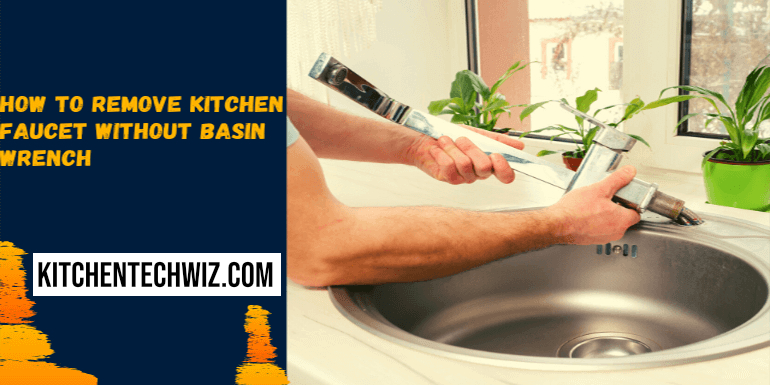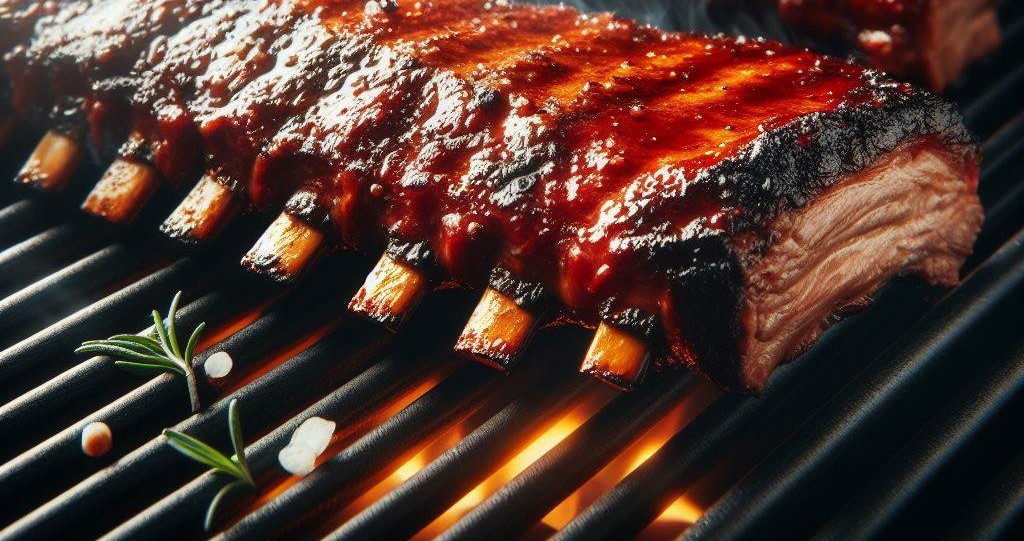As a DIY enthusiast, you may want to perform simple home repair procedures. One such procedure is the removal of a kitchen faucet.
You normally need a basin wrench to remove a kitchen faucet. But what happens if you don’t have a basin wrench? Is it really possible to do it?
Removing or replacing kitchen faucets can be tricky, especially without a wrench. But no need to worry!
There are plenty of alternative techniques you can try. In this guide, you’ll learn how to remove kitchen faucet without basin wrench.
What’s Basin Wrench?
A basin wrench, also known as a sink wrench, is a special tool for installing or removing a kitchen faucet.
It has a long shaft that can penetrate tight spaces under the sink to tighten or loosen the nuts. Such nuts under the sink are almost impossible to tighten or loosen with a normal wrench or pliers.
If you need to install or remove a kitchen or bathroom faucet, you’ll need a basin wrench. Unfortunately, not everyone has the luxury of owning a specialized basin wrench. The great news is there’re plenty of other options you can use if you need to have your faucet removed.
Also Read: How do you remove a grohe faucet handle
Remove Faucet Without Basin Wrench
It is important to ensure your kitchen faucet is clean before removing it. To clean the faucet, all your need is to wipe the faucet with a damp sponge or cloth. For stubborn stains, use vinegar or any cleaning product in your kitchen. With that in mind, here is what you’ll need to get the job with ease.
- Socket wrench
- Screwdriver
- A small piece of cloth or towel
- Grease or lubricating oil
1. Close the Valves to Cut Off Water Flow
The first step is to make sure no water is flowing through the faucet. You can do this by closing the valves that control water flow underneath the faucet. There will be a separate valve for hot water. Make sure you close both valves – for hot and cold water. If the valves are damaged, and you can’t close them tightly, go for the main valve near the meter.
2. Confirm the Water Flow Is Completely Blocked
Once you’ve closed the valves, switch your kitchen faucet on to check whether there is still some water flowing. Leave the faucet on for approximately two minutes. This allows all the air from the pipe to escape through the faucet.
3. Place a Bowl under the Faucet
There might be some small amount of water left in the pipes. Place a large basket, bowl, or container under the faucet to catch any water that was left. You must be cautious when disconnecting the pipes, especially the hot water pipe.
To remove water lines, it is advised to use water pump pliers. Modified tools may not work or may even damage the waterline. The cost of repair can be more than the price of a new basin wrench.
4. Loosen the Mounting Nuts
Once you’ve disconnected the water lines, lift out the faucet. Note some faucets are held with screws while others are tightened with nuts. Those held with nuts can easily be loosed with a simple socket wrench. In case your faucet is held with screws, use a screwdriver.
Rusty screws, bolts, and nuts can be tricky to remove. If the nuts or screws are stubborn, don’t use excessive force. Use WD-40® Spray grease to lubricate the stuck nuts or screws fast. After removing them, keep them in a safe place. If they fall down, there is a good chance you won’t see them again.
5. Remove the Faucet
When every nut or screw has been removed, you should now be able to remove the faucet. If there is a small resistance due to rust, apply grease again. Leave it there for several minutes. Carefully lift the faucet up. Again, applying too much pressure or using excessive force can damage the kitchen faucet.
Also Read: Best hard water kitchen faucets
What’s the best basin wrench alternative?
There are many tools you can use instead of a basin wrench. These include a socket wrench, screwdriver, or duct tape. Just make sure the alternative tool you are using can reach the nuts and loosen them without damaging the sink.
1. Duct tape
There are many awesome uses of duct tape, including removing pet hair, clearing toe-nail fungus, eliminating eyesores, fixing a tent, removing splinters, and so forth. But did you know that you can also use duct tape to loosen nuts? Yes, you read it right. Cut a length of around 12 inches. Divide it in the middle, so you are left with two strips of 12 inches in length. Stick one strip to the back (nonstick surface) side of the other strip. You are doing this because you want to make the strip stronger. Wrap around 4-5 inches of duct tape around the nut. Pull the remaining inches of duct tape in an anticlockwise direction to loosen the nut.
2. Two coins
Did you know that you can also use coins to loosen a nut? Place two coins on opposite sides of the nut. Use the knuckles of your middle fingers and index finger to and twist in the right direction to remove the nut.
3. Use bolts and nuts
This method requires you to have two nuts and two bolts. Attach one nut to a bolt and put it on the nut you wish to loosen. The goal is to grip the nut you want to loosen with another nut that you attached to the bolt. It should be between the head of the nut and the bolt (the bolt’s thread should be on top of the nut you want to loosen). Use the second nut to attach the two bolts tightly. Now turn the bolt in the right direction to remove the nut holding the sink faucet. This involves lots of effort and is not the most effective method to use.
Understanding the Kitchen Faucet Structure
The kitchen faucet structure is more intricate than it may seem at first glance. Understanding its components is crucial when attempting to remove it, especially without a basin wrench. The key parts of the faucet assembly include the handle, spout, aerator, cartridge, and connections. Each component plays a specific role in the functionality of the faucet and contributes to its overall performance.
One often overlooked aspect of the kitchen faucet structure is the cartridge – a vital part that controls water flow and temperature. Learning how this piece fits into the overall structure can provide valuable insight into troubleshooting common issues like leaks or inconsistent water flow. Additionally, understanding how the connections are configured can aid in disassembly without specialized tools. By gaining a comprehensive understanding of these structural elements, you can approach removing your kitchen faucet with confidence and efficiency.
Dealing with Stubborn or Rusty Faucets
Dealing with stubborn or rusty faucets can be a frustrating and time-consuming task. However, with the right approach, you can make the process much more manageable. Start by using a penetrating oil or lubricant to loosen the rust and corrosion around the base of the faucet. Allowing it to sit for several hours can help to break down any stubborn buildup, making it easier to remove the faucet without damaging adjacent components.
If the faucet is still refusing to budge, consider using a heat gun or hairdryer to gently warm up the area around the fittings. This can expand metal parts and assist in loosening tight connections. Remember that patience is key when dealing with stubborn faucets – rushing the removal process could lead to costly damage, so take your time and use gentle but firm pressure when attempting to loosen stuck parts.
By addressing stubborn or rusty faucets with these methods, you can avoid unnecessary frustration and potential damage during your kitchen faucet removal process. So next time you face a challenging faucet situation, remember that perseverance paired with careful techniques can often yield successful results without resorting to more invasive measures like drilling or cutting.
Frequently Asked Questions (FAQs)
The following are a few commonly asked questions about kitchen faucets and basin wrenches.
How do you remove a rusted nut?
We’ve already handled this question before. To remove a rusted nut that proves to be stubborn, apply some grease to the nuts and wait for several minutes. Then remove it with a socket wrench.
Can I loosen nuts with my hands?
Chances are, the person who tightened it didn’t use bare hands. Even if you wear a rubber glove, you may not be able to loosen a nut.
Is there a special wrench for the kitchen faucet?
Yes, there is a special wrench for kitchen faucets. This wrench is specifically designed to fit the nut on the faucet that holds it in place, and this wrench is usually called a basin wrench.
Final Thoughts
We’ve all experienced moments where we need to remove our kitchen faucets. Unfortunately, doing so requires a basin wrench, which we may not have in our homes. And as the old saying goes, use the right tool for the job. Using the wrong tool can result in significant damages that can be too expensive to fix. The right tool, in this case, is a basin wrench. Luckily, we’ve learned not having the basin wrench is not the end of the road when it comes to removing a sink faucet. We’ve discussed in detail in this post on how to remove kitchen faucet without a basin wrench.
Removing a kitchen faucet without a basin wrench may seem daunting at first, but with the right preparation and technique, it is definitely achievable. Throughout this guide, we have discussed various methods such as using adjustable wrenches, penetrating oil, and homemade tools to tackle this task. It is important to remember that patience and persistence are key when dealing with stubborn faucet nuts.



![16 Best Tabletop Propane Gas Grills 2024: [Also Charcoal & Electric]](https://kitchentechwiz.com/wp-content/uploads/2021/04/Best-Tabletop-Propane-Grill-1.jpg)

Leave a Reply